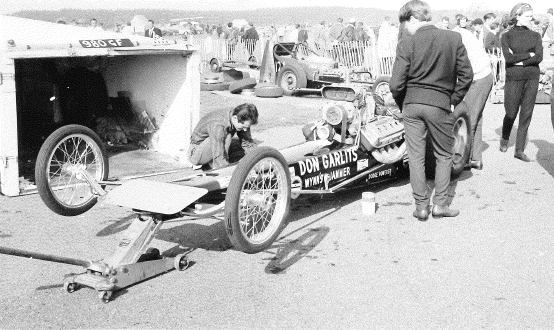Back in the Day: American drag racing stars make waves across the pond
In 1964, National Hot Rod Association (NHRA) founder Wally Parks collaborated with his British contemporary Sydney Allard to bring American drag racing to England. The duo utilized runways on Royal Air Force bases speckled across the country for make-shift drag strips. Race cars were shipped across the Atlantic Ocean on an old U.S. ocean liner, and in no time the Brits enjoyed a prolific six-stop exhibition of American drag racing. The tour was dubbed the International Drag Festival.
Emmett “Mike” Abdoney was fortunate enough to attend one of these events. Hungry to catch some racing action, he made the 220-mile drive from the base in Scotland where he was stationed as part of the U.S. Air Force’s 67th Air Rescue Squadron, to Southport England. Everything from classic slingshot dragsters to Willys coupes made scorching quarter-mile passes down the RAF Woodvale airstrip just outside of town. The American team roster was a who’s who of drag racing stars, including many future NHRA hall-of-famers like Don Garlits, Tommy Ivo, and Grumpy Jenkins.
Lucky for us, Emmett was handy with a camera and brought along his Kodak Retina 1A, loaded with 35mm film, to capture it all. When we asked readers to send in their photos from back in the day, Emmett sent us a cache of awesome black and white photography from the exhibition drag race in Southport.

“That’s me, with hair, standing in front of the engine,” says Emmett. Opposite of Emmet, a young Don Garlits with a slick-back coif crouches next to his Wynn’s Jammer, a Hemi-powered slingshot dragster.

Here, “TV” Tommy Ivo adjusts the cuffs of his club jacket as he talks to crew men behind his drag car. Ivo was known for his immaculate race cars, lavish glass-enclosed haulers, and frequent cameos on television sitcoms throughout the 1950s and ’60s. It only makes sense that he would be one of the stars on-hand for the International Drag Festival series.

Tony Nancy’s iconic Wedge pokes out of an enclosed trailer with its rear end propped up by two Valvoline barrels. Nancy is on his back under the car, prepping it for his next run. According to Speedway Motors Museum of American Speed, “In 1963, he [Nancy] reasoned there had to be a better way to travel the quarter-mile than looking sideways around a towering supercharged motor, not to mention the inherent risk of engine explosion and fire.” So he ditched the conventional front-engine slingshot design for a rear-engine aerodynamic wedge.
In addition to successful campaigns in the U.S. and England, Nancy took his revolutionary drag car to Monza, Italy, where he hit 195-miles per hour on a run down the grand prix track’s straightaway.

Ronnie Sox and Buddy Martin campaigned this Mercury Comet, powered by a burly 427-cubic-inch SOHC engine. It is considered the predecessor to the modern “flopper” funny car, running in NHRA’s Factory Experimental class where it was completely within the rule book to take an engine from a full-size sedan and cram it down into the engine compartment of a small coupe.
[Editor’s Note: In Hagerty magazine (Don’t have it? Get it here), we asked members to submit any vintage automotive photos they may have lying around, with the small caveat that they must own distribution rights for the photos. Select photos will be featured in the magazine’s new “Back in the Day” section. So far, the response has been overwhelming, so we started this weekly online version to publish submissions at a faster clip.
Whether the moments are captured by a professional photographer or an amateur voyeur, we want to them. Send your submissions via email to tips@hagerty.com or add them to our forums on the Back in the Day board.]


